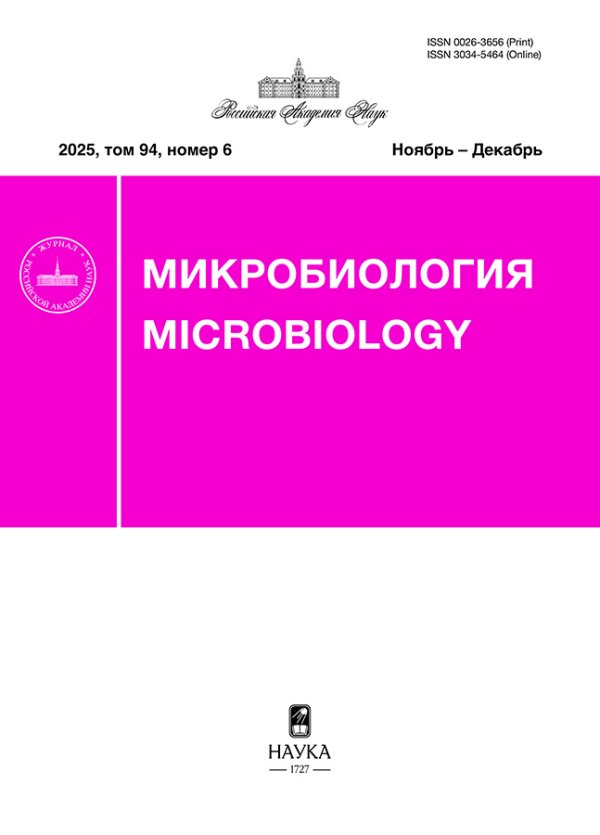Биоцидная активность наночастиц аспарагината хитозана
- Авторы: Шиповская А.Б.1, Луговицкая Т.Н.2, Зудина И.В.1
-
Учреждения:
- Саратовский национальный исследовательский государственный университет им. Н.Г. Чернышевского
- Уральский федеральный государственный университет им. первого Президента России Б.Н. Ельцина
- Выпуск: Том 92, № 1 (2023)
- Страницы: 68-76
- Раздел: ЭКСПЕРИМЕНТАЛЬНЫЕ СТАТЬИ
- URL: https://journals.rcsi.science/0026-3656/article/view/138171
- DOI: https://doi.org/10.31857/S0026365622600547
- EDN: https://elibrary.ru/NNDRBA
- ID: 138171
Цитировать
Полный текст
Аннотация
Исследована биологическая активность наночастиц аспарагината хитозана, образующихся в системе хитозан‒L-аспарагиновая кислота‒вода на начальном этапе фазового разделения, в отношении клеток эу- и прокариот. Культивирование Staphylococcus aureus 209 P и Escherichia coli 113-13 в питательной среде с добавлением наночастиц приводило к массированной гибели бактериальных культур. Наиболее высокое биоцидное действие проявлялось в отношении грамположительных бактерий. Биотестирование выявило высокую биосовместимость наночастиц хитозана и их способность ускорять пролиферативную активность эпидермальных и эпителиальных клеточных культур. Полученные результаты демонстрируют перспективность использования наночастиц аспарагината хитозана в медико-биологических и фармакологических приложениях.
Ключевые слова
Об авторах
А. Б. Шиповская
Саратовский национальный исследовательский государственный университетим. Н.Г. Чернышевского
Email: tlugovitskaja@mail.ru
Россия, 410012, Саратов
Т. Н. Луговицкая
Уральский федеральный государственный университет им. первого Президента России Б.Н. Ельцина
Автор, ответственный за переписку.
Email: tlugovitskaja@mail.ru
Россия, 620002, Екатеринбург
И. В. Зудина
Саратовский национальный исследовательский государственный университетим. Н.Г. Чернышевского
Email: tlugovitskaja@mail.ru
Россия, 410012, Саратов
Список литературы
- Гегель Н.О., Зудина И.В., Малинкина О.Н., Шиповская А.Б. Влияние изомерной формы аскорбиновой кислоты на антибактериальную активность ее солей с хитозаном // Микробиология. 2018. Т. 87. С. 618–623.
- Gegel N.O., Zudina I.V., Malinkina O.N., Shipovskaya A.B. Effect of ascorbic acid isomeric forms on antibacterial activity of its chitosan salts // Microbiology (Moscow). 2018. V. 87. P. 732–737.
- Ильина А.В., Варламов В.П., Ермаков Ю.А. Хитозан – полимер для формирования наночастиц // ДАH. 2008. Т. 421. № 2. С. 199–201.
- Il’ina A.V., Varlamov V.P., Skryabin K.G., Ermakov Yu.A., Orlov V.N. Chitosan is a natural polymer for constructing nanoparticles // Doklady Chem. 2008. V. 421. P. 165–167.
- Куликов С.Н., Шакирова Д.Р., Тихонов В.Е., Безродных Е.А., Ильина А.В., Левов А.Н., Варламов В.П. Антимикотическая активность хитозана и его производных в отношении Candida albicans // Проблемы медицинской микологии. 2012. Т. 14. № 4. С. 50–54.
- Луговицкая Т.Н., Шиповская А.Б. Физико-химические свойства водных растворов L-аспарагиновой кислоты с добавкой хитозана // Журн. общей химии. 2017. Т. 87. С. 650–656.
- Lugovitskaya T.N., Shipovskaya A.B. Physicochemical properties of aqueous solutions of L-aspartic acid containing chitosan // Russ. J. Gen. Chem. 2017. V. 87. P. 782–787.
- Луговицкая Т.Н., Зудина И.В., Шиповская А.Б. Получение и свойства аспарагиновокислых растворов хитозана // Журн. прикл. химии. 2020. Т. 93. С. 90–99.
- Lugovitskaya T.N., Zudina I.V., Shipovskaya A.B. Obtaining and properties of L-aspartic acid solutions of chitosan // Russ. J. Appl. Chem. 2020. V. 93. P. 80–88.
- Набережных Г.А., Горбач В.И., Лихацкая Г.Н., Давыдова В.Н., Соловьева Т.Ф. Взаимодействие хитозанов и N-ацилированных производных хитозанов с липополисахаридами грамотрицательных бактерий // Биохимия. 2008. Т. 73. С. 530–541.
- Naberezhnykh G.A., Gorbach V.I., Likhatskaya G.N., Davidova V.N., Solov’eva T.F. Interaction of chitosans and their N-acylated derivatives with lipopolysaccharide of gram-negative bacteria // Biochemistry (Moscow). 2008. V. 73. P. 432–441.
- Полюдова Т.В., Шагдарова Б.Ц., Коробовa В.П., Варламов В.П. Бактериальная адгезия и образование биопленок в присутствии хитозана и его производных // Микробиология. 2019. Т. 88. С. 129–136.
- Polyudova T.V., Korobov V.P., Shagdarova B.T., Varlamov V.P. Bacterial adhesion and biofilm formation in the presence of chitosan and its derivatives // Microbiology (Moscow). 2019. V. 88. P. 125–131.
- Салтыкова Е.С., Гайфуллина Л.Р., Каскинова М.Д., Гатауллин А.Р., Матниязов Р.Т., Поскряков А.В., Николенко А.Г. Действие хитозана на развитие микроспоридий Nosema apis в медоносных пчелах // Микробиология. 2018. Т. 87. С. 624–630.
- Saltykova E.S., Gaifullina L.R., Kaskinova M.D., Gataullin A.R., Matniyazov R.T., Poskryakov A.V., Nikolenko A.G. Effect of chitosan on development of Nosema apis microsporidia in honey bees // Microbiology (Moscow). 2018. V. 87. P. 738–743.
- Шиповская А.Б., Малинкина О.Н., Гегель Н.О., Зудина И.В., Луговицкая Т.Н. Структура и свойства солевых комплексов хитозана с диастереомерами аскорбиновой кислоты // Изв. АН. Сер. химич. 2021. № 9. С. 1765–1774.
- Shipovskaya A.B., Malinkina O.N., Gegel N.O., Zudina I.V., Lugovitskaya T.N. Structure and properties of chitosan salt complexes with ascorbic acid diastereomers // Russ. Chem. Bull. 2021. V. 70. P. 1765–1774.
- Ayon N.J. Features, roles and chiral analyses of proteinogenic amino acids // AIMS Mol. Sci. 2020. V. 7. P. 229–268.
- Babicheva T.S., Gegel N.O., Shipovskaya A.B. Visualization of morphological features of chitosan microtubes during biodegradation // J. Phys.: Conf. Ser. – IOP Publishing, 2017. Iss. 4. P. 042026.
- Chandrasekaran M., Kim K.D., Chun S.C. Antibacterial activity of chitosan nanoparticles: a review // Processes. 2020. V. 8. P. 1173.
- Divya K., Jisha M.S. Chitosan nanoparticles preparation and applications // Environ. Chem. Lett. 2018. V. 16. P. 101–112.
- Gegel N.O., Zhuravleva Yu.Yu., Shipovskaya A.B., Malinkina O.N., Zudina I.V. Influence of chitosan ascorbate chirality on the gelation kinetics and properties of silicon-chitosan-containing glycerohydrogels // Polymers. 2018. V. 10. P. 259.
- Howling G.I., Dettmar P.W., Goddard P.A., Hampson F.C., Dornish M., Wood E.J. The effect of chitin and chitosan on the proliferation of human skin fibroblasts and keratinocytes in vitro // Biomaterials. 2001. V. 22. P. 2959–2966.
- Jhaveri J., Raichura Z., Khan T., Momin M., Omri A. Chitosan nanoparticles-insight into properties, functionalization and applications in drug delivery and theranostics // Molecules. 2021. V. 26. P. 272.
- Kong M., Chen X.G., Xing K., Park H.J. Antimicrobial properties of chitosan and mode of action: a state of the art review // Int. J. Food Microbiol. 2010. V. 144. P. 51–63.
- Kravanja G., Primožič M., Knez Ž., Leitgeb M. Chitosan-based (nano) materials for novel biomedical applications // Molecules. 2019. V. 24. P. 1960.
- Lau H.K., Kiick K.L. Opportunities for multicomponent hybrid hydrogels in biomedical applications // Biomacromolecules. 2015. V. 16. P. 28–42.
- Luangtana-Anan M., Nunthanid J., Limmatvapirat S. Potential of different salt forming agents on the formation of chitosan nanoparticles as carriers for protein drug delivery systems // J. Pharm. Investigation. 2017. V. 49. P. 37–44.
- Lugovitskaya T.N., Shipovskaya A.B., Shmakov S.L., Shipenok X.M. Formation, structure, properties of chitosan aspartate and metastable state of its solutions for obtaining nanoparticles // Carbohydr. Polym. 2022. V. 277. P. 118773.
- Marciello M., Rossi S., Caramella C., Remunan-Lopez C. Freeze-dried cylinders carrying chitosan nanoparticles for vaginal peptide delivery // Carbohydr. Polym. 2017. V. 170. P. 43–51.
- Másson M., Holappa J., Hjálmarsdóttir M., Rúnarsson Ö.V., Nevalainen T., Järvinen T. Antimicrobial activity of piperazine derivatives of chitosan // Carbohydr. Polym. 2008. V. 74. P. 566–571.
- Mohammed M.A., Syeda J., Wasan K.M., Wasan E.K. An overview of chitosan nanoparticles and its application in non-parenteral drug delivery // Pharmaceutics. 2017. V. 9. Is. 4. P. 53.
- Mubarak Ali D., Lewis Oscar F., Gopinath V., Alharbi N.S., Alharbi S.A., Thajuddin N. An inhibitory action of chitosan nanoparticles against pathogenic bacteria and fungi and their potential applications as biocompatible antioxidants // Microb. Pathog. 2018. V. 114. P. 323–327.
- Muzzarelli R.A.A. Chitosan composites with inorganics, morphogenetic proteins and stem cells, for bone regeneration. Review article // Carbohydr. Polym. 2011. V. 83. P. 1433–1445.
- No H.K., Park N.Y., Lee S.H., Meyers S.P. Antibacterial activity of chitosans and chitosan oligomers with different molecular weights // Int. J. Food Microbiol. 2002. V. 74. P. 65–72.
- Raafat D., Von Bargen K., Haas A., Sahl H.G. Insight into the mode of action of chitosan as an antibacterial compound // Appl. Environ. Microbiol. 2008. V. 74. P. 3764–3773.
- Rhoades J., Roller S. Antimicrobial actions of degraded and native chitosan against spoilage organisms in laboratory media and foods // Appl. Environ. Microbiol. 2000. V. 66. P. 80–86.
- Rinaudo M. Chitin and chitosan: properties and applications // Prog. Polym. Sci. 2006. V. 31. P. 603–632.
- Rossi S., Vigani B., Puccio A., Bonferoni M.C., Sandri G., Ferrari F. Chitosan ascorbate nanoparticles for the vaginal delivery of antibiotic drugs in atrophic vaginitis // Marine Drugs. 2017. V. 15. P. 319.
- Rozman N.A.S., Tong W.Y., Leong C.R., Tan W.N., Hasanolbasori M.A., Abdullah S.Z. Potential antimicrobial applications of chitosan nanoparticles (ChNP) // J. Microbiol. Biotechnol. 2019. V. 29. P. 1009–1013.
- Stie M.B., Gätke J.R., Wan F., Chronakis I.S., Jacobsen J., Nielsen H.M. Swelling of mucoadhesive electrospun chitosan/polyethylene oxide nanofibers facilitates adhesion to the sublingual mucosa // Carbohydr. Polym. 2020. V. 242. P. 116428.
- Supraja N., Thiruchenduran S., Prasad T. Synthesis and characterization of chitosan nanoparticles and evaluation of antimicrobial activity antioxidant activity // Advancement Bioequiv. Bioavailab. 2018. V. 2. P. 88–93.
- Yu J., Wang D., Geetha N., Khawar K.M., Jogaiah S., Mujtaba M. Current trends and challenges in the synthesis and applications of chitosan-based nanocomposites for plants: a review // Carbohydr. Polym. 2021. V. 261. P. 117904.













